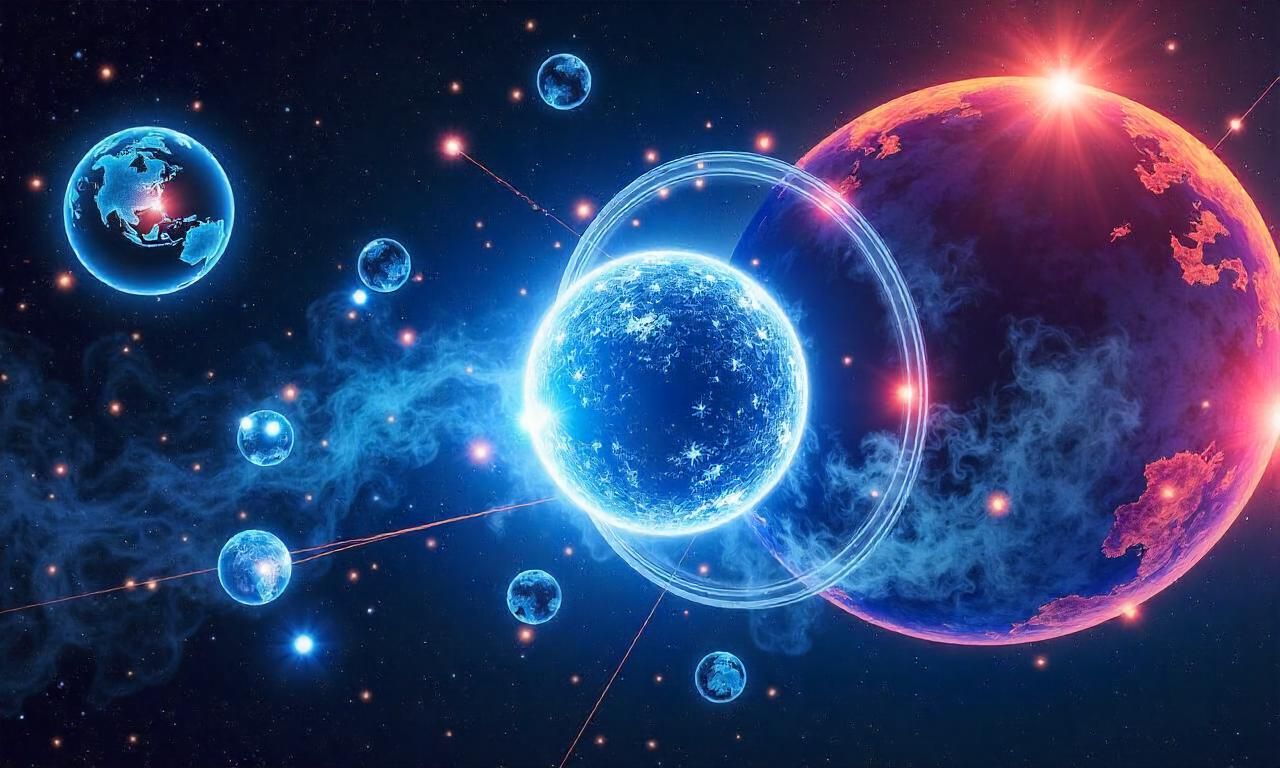The year 2023 marked a significant milestone in the science breakthroughs 2023 that have the potential to reshape our understanding of the universe and improve human life. From advancements in renewable energy to breakthroughs in medicine and artificial intelligence, the scientific community delivered transformative innovations that address global challenges and open new frontiers of knowledge. These discoveries not only highlight the rapid pace of technological progress but also demonstrate the power of human curiosity and collaboration. Let’s explore the science breakthroughs 2023 that stood out and how they are revolutionizing industries, ecosystems, and everyday existence. Renewable Energy and Sustainable Technologies The science breakthroughs 2023 in renewable energy have brought us closer to a sustainable future by tackling some of the most pressing challenges in energy production and storage. Innovations in fusion power, solar technology, and battery efficiency have collectively redefined how we generate and consume energy. Breakthrough in Fusion Power One of the most bold achievements in 2023 was the successful demonstration of science breakthroughs 2023 in fusion power. Researchers at the National Ignition Facility (NIF) in the United States achieved a net energy gain in a fusion reaction, marking a critical step toward harnessing the same energy source that powers the sun. This breakthrough means that science breakthroughs 2023 could eventually provide a nearly limitless, clean, and safe energy solution. The fusion experiment involved italic lasers that compressed hydrogen isotopes to temperatures exceeding 1.5 billion degrees Celsius, resulting in a reaction that produced more energy than it consumed. While this milestone is still in the early stages, it has sparked global interest in scaling up fusion technology. The implications of this science breakthroughs 2023 are vast, as fusion energy could eliminate reliance on fossil fuels and reduce greenhouse gas emissions. Advancements in Solar Technology Another key science breakthroughs 2023 was the development of more efficient solar panels. Scientists introduced perovskite-silicon tandem solar cells, which achieved a record efficiency of over 33%. This innovation combines the advantages of perovskite materials (high light absorption) with silicon’s durability, enabling italic more cost-effective and scalable solar energy solutions. These science breakthroughs 2023 also include breakthroughs in photovoltaic technology and solar storage systems. For instance, new materials like graphene-based solar films are lighter and more flexible, allowing for integration into building structures and portable devices. Meanwhile, advancements in battery storage have improved the reliability of solar energy by extending storage capacity and reducing degradation over time. Medicine and Biotechnology The science breakthroughs 2023 in medicine have revolutionized healthcare by improving treatments for diseases, extending human lifespans, and enhancing our ability to combat global health crises. From breakthroughs in mRNA vaccines to genetic engineering innovations, these developments offer hope and practical solutions for a healthier future. mRNA Vaccines and Therapeutic Applications The success of mRNA vaccines in 2023 extended beyond the pandemic, paving the way for italic personalized medicine and targeted therapies. Researchers developed mRNA-based treatments for conditions like cancer and rare genetic disorders, demonstrating the versatility of this technology. For example, a new science breakthroughs 2023 in mRNA vaccines for solid tumors allowed for bold tailored immune responses against specific cancer cells. This innovation has italic profound implications for medicine. Unlike traditional vaccines, which require growing viruses in labs, mRNA vaccines can be rapidly designed and produced, making them ideal for italic addressing emerging infectious diseases and chronic illnesses. The science breakthroughs 2023 in this field have also reduced production costs, making advanced therapies more accessible to underserved populations. CRISPR Breakthroughs and Gene Editing CRISPR technology continued to bold evolve in 2023, with significant advancements in gene editing precision and safety. Scientists developed italic a new CRISPR-Cas9 variant that minimizes off-target effects, reducing the risk of unintended genetic modifications. This science breakthroughs 2023 has made gene therapy a more viable option for treating genetic disorders such as sickle cell anemia and muscular dystrophy. In addition, italic CRISPR-based tools for early disease detection have been refined, enabling bold rapid diagnosis of conditions like Alzheimer’s and cancer. These science breakthroughs 2023 highlight the potential of genetic engineering to italic revolutionize medicine by addressing root causes of diseases rather than just symptoms. The ability to edit genes with unprecedented accuracy has also opened doors to bold regenerative medicine and personalized treatments tailored to an individual’s genetic profile. AI and Quantum Computing The science breakthroughs 2023 in artificial intelligence (AI) and quantum computing have accelerated the development of smarter systems, faster processors, and more efficient algorithms. These innovations are transforming industries from healthcare to cybersecurity and are redefining the limits of computational power. Quantum Computing Breakthroughs In 2023, quantum computing saw bold progress with the introduction of italic error-corrected qubits, which significantly improved the stability of quantum processors. This science breakthroughs 2023 has enabled bold quantum computers to perform complex calculations that were previously unattainable, such as simulating molecular structures for drug discovery or optimizing supply chains at an unprecedented scale. Researchers also made strides in quantum communication, developing italic secure networks that use bold quantum entanglement to transmit information without interception. These science breakthroughs 2023 are not just theoretical—they are now being tested in real-world applications, from bold quantum cryptography to quantum-enhanced AI models that process data faster and more efficiently than classical systems. AI in Drug Discovery and Beyond AI-driven drug discovery became a bold science breakthroughs 2023 in 2023, with algorithms capable of predicting protein structures and designing molecules in record time. Companies like DeepMind and others leveraged italic machine learning models to accelerate the development of bold new medications for conditions like diabetes and cardiovascular diseases. Moreover, AI has been integrated into italic healthcare diagnostics, enabling bold AI-powered imaging tools to detect diseases such as italic cancer and italic neurodegenerative disorders with higher accuracy than human experts. The science breakthroughs 2023 in this area also include bold AI-driven climate models that predict environmental changes with greater precision, helping scientists and policymakers make informed decisions. Space Exploration and Astronomy The science breakthroughs 2023 in space exploration and astronomy have expanded our knowledge of the
Discover the Science Behind Everyday Life
Science is not confined to laboratories or academic journals; it permeates every aspect of our daily lives. From the moment we wake up to the time we go to sleep, science in everyday life is at work, shaping the way we interact with the world. Whether it’s the physics of gravity keeping us grounded, the chemistry of cleaning products, or the biology of our bodies, science is the invisible force that makes life possible. Understanding the science in everyday life can reveal the hidden logic behind simple actions and help us appreciate the complexity of the natural world. This article explores how scientific principles underpin our routines, making it clear that science is both fascinating and practical. The Science in Everyday Life: A Hidden World The science in everyday life is a fascinating intersection of knowledge and application, where abstract concepts become tangible through real-world experiences. Science is not just about equations or experiments; it’s the foundation of innovation, problem-solving, and discovery. Every time we use a smartphone, cook a meal, or take medicine, we’re engaging with scientific principles. This section delves into how science operates in our daily routines, highlighting its role in technology, health, and the environment. The Physics of Daily Activities Physics, the study of matter and energy, is the backbone of many everyday phenomena. For example, the science in everyday life is evident when you pour water from a glass—it follows the law of gravity, which ensures it falls to the ground. Similarly, the science in everyday life is reflected in the friction between your shoes and the floor, allowing you to walk without slipping. Even something as simple as opening a door involves physics: the science in everyday life of torque and rotational motion explains how the handle’s design makes it easier to rotate the door. In a broader sense, physics also governs the way light reflects off surfaces, enabling us to see our surroundings. The <strong>science in everyday life</strong> is further illustrated by the refraction of light through glasses or lenses, which corrects vision impairments. These examples show that physics is not a distant field but a practical science that shapes our interactions with the physical world. The Chemistry in Our Routines Chemistry, the study of matter and its transformations, is another key player in the science in everyday life. Consider the process of cooking: when you heat an egg, the proteins denature and coagulate, changing its texture and color. Similarly, the science in everyday life is present in household cleaning, where chemical reactions between substances like vinegar and baking soda create bubbles that lift dirt. The <strong>science in everyday life</strong> also extends to personal care products. For instance, the <strong>chemistry in everyday life</strong> of surfactants in soap allows it to mix with water and remove oils from our skin. Even the <strong>science in everyday life</strong> of combustion in car engines relies on chemical reactions to power our transportation. These examples demonstrate how chemistry is integral to our daily experiences, often without us realizing it. The Biology of Health and Wellness Biology, the study of living organisms, is deeply embedded in the science in everyday life. Our bodies function based on biological processes, from the way we digest food to the mechanisms behind disease and healing. For instance, the science in everyday life of the human immune system explains how white blood cells fight infections, while the science in everyday life of genetics determines our traits and susceptibility to certain conditions. The <strong>science in everyday life</strong> is also visible in the way plants and animals interact with their environments. Photosynthesis, a biological process, converts sunlight into energy, sustaining ecosystems. Meanwhile, the <strong>science in everyday life</strong> of microbiology underpins the production of yogurt and cheese, showcasing how biology influences food and health. These insights highlight the importance of biology in maintaining our well-being and understanding the natural world. Science in Cooking and Nutrition Cooking is a perfect example of how science in everyday life manifests in our kitchens. From the science in everyday life of heat transfer to the chemical changes in food, every step of the cooking process is governed by scientific principles. Understanding these concepts can elevate our culinary skills and even improve our health. The Chemistry of Cooking Techniques Chemistry plays a crucial role in the science in everyday life of cooking. When you bake a cake, the science in everyday life of leavening agents like baking soda or yeast causes the dough to rise by producing carbon dioxide gas. Similarly, the science in everyday life of caramelization occurs when sugars in food are heated, creating a golden-brown color and rich flavor. For instance, the <strong>science in everyday life</strong> of emulsification explains how oil and water mix in dressings or mayonnaise, creating a stable blend. The <strong>science in everyday life</strong> of Maillard reactions, which occur when proteins and sugars are heated, gives grilled meats their characteristic aroma and taste. These chemical processes are not just fascinating—they are essential for creating the meals we enjoy. Physics in the Kitchen Physics also shapes the way we prepare and cook food. The science in everyday life of heat conduction determines how quickly a pan heats up, influencing the cooking time of different dishes. Meanwhile, the science in everyday life of convection ensures that air circulates efficiently in an oven, promoting even cooking. The <strong>science in everyday life</strong> of steam pressure in pressure cookers allows food to cook faster by increasing the boiling point of water, which is a direct application of <strong>thermodynamics</strong>. Even the <strong>science in everyday life</strong> of sound waves is relevant when using a microwave, where microwaves penetrate food and agitate water molecules, generating heat. These physical principles make cooking more efficient and enjoyable. Biology and Nutrition Biology is central to the science in everyday life of nutrition. Our bodies rely on nutrients from food to function, and the science in everyday life of digestion involves complex biochemical processes. For example, enzymes in the digestive system break down food into absorbable components,
How Culture Evolves Over Time: A Historical Journey
Cultural evolution over time is a fascinating process that reflects the dynamic nature of human societies. From ancient traditions to modern innovations, culture continuously adapts, transforms, and reshapes itself in response to environmental, technological, and social changes. This article explores the cultural evolution over time through a historical lens, examining key periods and the factors that have influenced the development of human customs, beliefs, and practices. By analyzing these transformations, we gain insight into how cultural evolution over time has shaped the world we live in today. The Foundations of Cultural Evolution The Role of Survival and Adaptation The earliest forms of cultural evolution over time can be traced back to prehistoric societies, where human survival was the primary driver of change. As early humans migrated across continents, they encountered new environments, which necessitated the development of new tools, languages, and social structures. These adaptations were not just practical but also laid the groundwork for the transmission of knowledge across generations. For example, the invention of agriculture during the Neolithic Revolution marked a pivotal shift in human society. It allowed communities to settle in one place, leading to the rise of complex societies and the emergence of cultural practices tied to farming, such as rituals to honor the land and organized labor systems. The Emergence of Shared Values As cultural evolution over time progressed, shared values and norms began to form. These values were often shaped by the environmental challenges and resource availability of a society. For instance, in arid regions, water conservation practices became deeply ingrained in daily life, influencing everything from architecture to religious beliefs. Similarly, in coastal communities, maritime traditions developed as a response to the sea’s role in sustenance and trade. The creation of symbols, such as art and language, allowed humans to communicate and preserve their identity, fostering a sense of community and continuity. This early stage of cultural evolution over time set the foundation for more complex and interconnected cultures in later periods. Ancient Civilizations: Catalysts of Cultural Evolution The Interplay of Geography and Culture Ancient civilizations, such as Egypt, Mesopotamia, and the Indus Valley, exemplified how cultural evolution over time is influenced by geographical factors. The Nile River in Egypt, for example, shaped the development of agricultural techniques, religious practices, and social hierarchies. The Tigris and Euphrates Rivers in Mesopotamia facilitated the rise of urban centers and legal systems, while the Indus Valley's advanced drainage systems reflected a society that prioritized hygiene and organization. These cultural evolution over time examples show how natural resources and landscapes dictated the pace and direction of societal development. The Transmission of Knowledge Through Trade Trade routes like the Silk Road and the Trans-Saharan Trade Network played a critical role in cultural evolution over time. These networks enabled the exchange of goods, ideas, and technologies, creating a melting pot of influences. For instance, Greek philosophy spread to the Persian Empire through trade and conquest, while Buddhism traveled from India to East Asia, adapting to local traditions along the way. The cultural evolution over time during this period was characterized by cross-cultural interactions, which led to the blending of art, religion, and language. This era laid the groundwork for global cultural exchange, a concept that would become even more pronounced in the following centuries. The Medieval Period: Tradition and Transformation The Dominance of Religion in Cultural Identity The medieval period, spanning roughly from the 5th to the 15th century, was defined by religion as a central force in shaping cultural evolution over time. In Europe, the Christian Church not only dictated spiritual life but also influenced political structures, artistic expressions, and educational systems. Monasteries became centers of learning, preserving classical knowledge and fostering the cultural evolution over time of literacy and scholarship. Meanwhile, in the Islamic world, cultural evolution over time was driven by scientific advancements and philosophical inquiry, as seen in the House of Wisdom in Baghdad, which became a hub for intellectual exchange. The Impact of Conquests and Empires Conquests by empires such as the Roman Empire, Byzantine Empire, and Mongol Empire accelerated cultural evolution over time through forced assimilation and integration of diverse traditions. The Roman Empire’s expansion brought Latin to much of Europe, influencing language, laws, and architecture. The Mongol Empire’s vast reach facilitated the cultural evolution over time of trade and technology, as the Pax Mongolica allowed the spread of innovations like papermaking and gunpowder. These interactions often led to hybrid cultures, where elements from different societies merged to create new traditions. For example, the blending of Persian, Arab, and Turkic influences in the Middle East gave rise to distinctive art styles and musical forms that persisted for centuries. The Renaissance and Enlightenment: A New Dawn of Cultural Evolution The Revival of Classical Ideals The Renaissance (14th to 17th century) marked a cultural evolution over time driven by humanism and renewed interest in classical antiquity. This period saw the rediscovery of Greco-Roman texts, advancements in art and science, and the emergence of individualism. Figures like Leonardo da Vinci and Michelangelo revolutionized artistic techniques, while Galileo Galilei and Isaac Newton redefined scientific understanding. The cultural evolution over time during the Renaissance was accelerated by trade and exploration, as new ideas and goods flowed across Europe, Asia, and Africa, fostering cultural diversity and innovation. The Enlightenment and the Spread of Ideas The Enlightenment (17th to 18th century) further propelled cultural evolution over time by emphasizing reason, science, and secularism. Thinkers like Voltaire, Rousseau, and Montesquieu challenged traditional authority and religious dogma, promoting democratic ideals and individual rights. The printing press, invented by Johannes Gutenberg, played a key role in this cultural evolution over time by enabling the mass production of books, which spread new philosophies and scientific theories. This era also saw the rise of nationalism, as cultural evolution over time began to be tied to national identities and shared histories. The cultural evolution over time during the Enlightenment laid the foundation for the modern world’s political and social structures. The Modern Era: Globalization and
Cultural Influences on Fashion Trends: A Global Perspective
Fashion is more than just clothing; it is a dynamic reflection of cultural influences on fashion trends, shaped by history, geography, traditions, and societal values. Across the globe, cultural influences on fashion trends have played a pivotal role in defining what people wear, how they express identity, and how styles evolve over time. From the vibrant textiles of African heritage to the minimalist elegance of Japanese design, cultural influences on fashion trends are embedded in every stitch and silhouette. This article explores the intricate relationship between culture and fashion, examining how traditions, innovations, and global interactions have created a rich tapestry of cultural influences on fashion trends that continue to influence the world of style today. The Historical Roots of Cultural Influences on Fashion Trends Ancient Civilizations and Their Legacy in Fashion The earliest cultural influences on fashion trends can be traced back to ancient civilizations, where clothing was deeply intertwined with social hierarchy, religious beliefs, and environmental needs. In ancient Egypt, for example, cultural influences on fashion trends were evident in the use of linen, a fabric that symbolized purity and was reserved for the elite. Similarly, in ancient Greece, draped garments like the chiton and himation reflected the values of modesty and functionality. These early practices laid the foundation for how cultural influences on fashion trends continue to shape modern aesthetics. Bold: The cultural fabric of ancient societies not only dictated what people wore but also served as a visual language to communicate status, spirituality, and community. For instance, ancient Rome introduced the toga as a symbol of Roman citizenship, while ancient China emphasized the use of silk, which became a hallmark of wealth and refinement. These cultural influences on fashion trends were not just about appearance—they were about identity and heritage. The Role of Tradition in Shaping Style Tradition has always been a cornerstone of cultural influences on fashion trends, preserving the essence of a community’s values and customs. In many cultures, traditional attire is worn during significant events such as weddings, festivals, or religious ceremonies. The Indian sari, for example, has evolved from its ancient roots into a versatile garment that adapts to modern trends while retaining its cultural symbolism. Similarly, the Japanese kimono, once a staple of daily wear, is now celebrated as a cultural icon in fashion shows and high-end collections. These examples highlight how cultural influences on fashion trends are not static but continue to evolve while honoring their origins. Italic: Tradition acts as a bridge between the past and present, allowing cultural narratives to influence contemporary fashion. In Indigenous cultures, for instance, handwoven textiles and natural dyes are not only practical but also carry deep spiritual meanings. The Maori of New Zealand incorporate traditional patterns into modern clothing, blending ancestral artistry with global design sensibilities. This interplay between heritage and innovation underscores the enduring impact of cultural influences on fashion trends. Regional Cultural Influences on Fashion Trends The Vibrancy of African Fashion African fashion is a powerful testament to cultural influences on fashion trends, with its rich heritage of patterns, colors, and fabrics. The African Ankara fabric, for example, has become a global symbol of cultural pride, often worn in traditional attire such as the kanga (a rectangular cloth used as a garment or decorative item) and the dashiki (a colorful jacket originating from West Africa). These designs are not only aesthetically striking but also convey messages about identity, status, and even political movements. Bold: The African continent is a melting pot of cultural influences on fashion trends, where regional diversity translates into a wide array of styles. In West Africa, the indigo-dyed garments of the Ashanti people reflect their connection to nature and craftsmanship, while East African kanga designs often incorporate proverbs and social commentary. This regional specificity ensures that cultural influences on fashion trends remain deeply rooted in local contexts, even as they gain international recognition. The Timeless Appeal of Asian Fashion Asian cultures have long contributed to cultural influences on fashion trends, blending practicality with artistry. The Chinese Hanfu, a flowing robe that dates back over 3,000 years, continues to inspire modern designers with its emphasis on balance and harmony. Meanwhile, Japanese kimono remains a symbol of elegance, with its intricate embroidery and seasonal variations reflecting the philosophy of wabi-sabi (the beauty of imperfection). Italic: Asian fashion trends often emphasize functionality and aesthetics in equal measure, showcasing how cultural influences on fashion trends can transcend time. In South Korea, the influence of Korean pop culture has led to the rise of Korean streetwear, which fuses traditional elements with futuristic designs. This duality highlights how cultural influences on fashion trends are not confined to the past but are actively reimagined in the present. European Cultural Heritage and Its Global Impact Europe has been a central hub for cultural influences on fashion trends, with its historical garments serving as the blueprint for many modern styles. The Medieval European chainmail and Renaissance garments set the stage for the evolution of cultural influences on fashion trends in the West. The French haute couture of the 19th and 20th centuries, for instance, became a global standard, influencing everything from runway collections to everyday fashion. Bold: European fashion is a blend of history, art, and innovation, with cultural influences on fashion trends rooted in centuries of craftsmanship. The British Victorian era introduced structured silhouettes and high collars, which are still referenced in modern formal wear. Meanwhile, Italian fashion has long been associated with luxury and sleek designs, reflecting the country’s deep cultural ties to art and elegance. These historical influences continue to shape cultural influences on fashion trends in the 21st century. Globalization and the Blending of Cultural Influences on Fashion Trends Cross-Cultural Fusion in Modern Fashion The cultural influences on fashion trends have become increasingly intertwined in the era of globalization, where ideas, materials, and styles cross borders effortlessly. Western streetwear, for example, has absorbed elements from African prints, Japanese minimalism, and Indian embroidery, creating a new wave of cultural influences on fashion
Cultural Influences on Fashion Trends: A Global Perspective
Fashion is more than just clothing; it is a dynamic reflection of cultural influences on fashion trends, shaped by history, geography, traditions, and societal values. Across the globe, cultural influences on fashion trends have played a pivotal role in defining what people wear, how they express identity, and how styles evolve over time. From the vibrant textiles of African heritage to the minimalist elegance of Japanese design, cultural influences on fashion trends are embedded in every stitch and silhouette. This article explores the intricate relationship between culture and fashion, examining how traditions, innovations, and global interactions have created a rich tapestry of cultural influences on fashion trends that continue to influence the world of style today. The Historical Roots of Cultural Influences on Fashion Trends Ancient Civilizations and Their Legacy in Fashion The earliest cultural influences on fashion trends can be traced back to ancient civilizations, where clothing was deeply intertwined with social hierarchy, religious beliefs, and environmental needs. In ancient Egypt, for example, cultural influences on fashion trends were evident in the use of linen, a fabric that symbolized purity and was reserved for the elite. Similarly, in ancient Greece, draped garments like the chiton and himation reflected the values of modesty and functionality. These early practices laid the foundation for how cultural influences on fashion trends continue to shape modern aesthetics. Bold: The cultural fabric of ancient societies not only dictated what people wore but also served as a visual language to communicate status, spirituality, and community. For instance, ancient Rome introduced the toga as a symbol of Roman citizenship, while ancient China emphasized the use of silk, which became a hallmark of wealth and refinement. These cultural influences on fashion trends were not just about appearance—they were about identity and heritage. The Role of Tradition in Shaping Style Tradition has always been a cornerstone of cultural influences on fashion trends, preserving the essence of a community’s values and customs. In many cultures, traditional attire is worn during significant events such as weddings, festivals, or religious ceremonies. The Indian sari, for example, has evolved from its ancient roots into a versatile garment that adapts to modern trends while retaining its cultural symbolism. Similarly, the Japanese kimono, once a staple of daily wear, is now celebrated as a cultural icon in fashion shows and high-end collections. These examples highlight how cultural influences on fashion trends are not static but continue to evolve while honoring their origins. Italic: Tradition acts as a bridge between the past and present, allowing cultural narratives to influence contemporary fashion. In Indigenous cultures, for instance, handwoven textiles and natural dyes are not only practical but also carry deep spiritual meanings. The Maori of New Zealand incorporate traditional patterns into modern clothing, blending ancestral artistry with global design sensibilities. This interplay between heritage and innovation underscores the enduring impact of cultural influences on fashion trends. Regional Cultural Influences on Fashion Trends The Vibrancy of African Fashion African fashion is a powerful testament to cultural influences on fashion trends, with its rich heritage of patterns, colors, and fabrics. The African Ankara fabric, for example, has become a global symbol of cultural pride, often worn in traditional attire such as the kanga (a rectangular cloth used as a garment or decorative item) and the dashiki (a colorful jacket originating from West Africa). These designs are not only aesthetically striking but also convey messages about identity, status, and even political movements. Bold: The African continent is a melting pot of cultural influences on fashion trends, where regional diversity translates into a wide array of styles. In West Africa, the indigo-dyed garments of the Ashanti people reflect their connection to nature and craftsmanship, while East African kanga designs often incorporate proverbs and social commentary. This regional specificity ensures that cultural influences on fashion trends remain deeply rooted in local contexts, even as they gain international recognition. The Timeless Appeal of Asian Fashion Asian cultures have long contributed to cultural influences on fashion trends, blending practicality with artistry. The Chinese Hanfu, a flowing robe that dates back over 3,000 years, continues to inspire modern designers with its emphasis on balance and harmony. Meanwhile, Japanese kimono remains a symbol of elegance, with its intricate embroidery and seasonal variations reflecting the philosophy of wabi-sabi (the beauty of imperfection). Italic: Asian fashion trends often emphasize functionality and aesthetics in equal measure, showcasing how cultural influences on fashion trends can transcend time. In South Korea, the influence of Korean pop culture has led to the rise of Korean streetwear, which fuses traditional elements with futuristic designs. This duality highlights how cultural influences on fashion trends are not confined to the past but are actively reimagined in the present. European Cultural Heritage and Its Global Impact Europe has been a central hub for cultural influences on fashion trends, with its historical garments serving as the blueprint for many modern styles. The Medieval European chainmail and Renaissance garments set the stage for the evolution of cultural influences on fashion trends in the West. The French haute couture of the 19th and 20th centuries, for instance, became a global standard, influencing everything from runway collections to everyday fashion. Bold: European fashion is a blend of history, art, and innovation, with cultural influences on fashion trends rooted in centuries of craftsmanship. The British Victorian era introduced structured silhouettes and high collars, which are still referenced in modern formal wear. Meanwhile, Italian fashion has long been associated with luxury and sleek designs, reflecting the country’s deep cultural ties to art and elegance. These historical influences continue to shape cultural influences on fashion trends in the 21st century. Globalization and the Blending of Cultural Influences on Fashion Trends Cross-Cultural Fusion in Modern Fashion The cultural influences on fashion trends have become increasingly intertwined in the era of globalization, where ideas, materials, and styles cross borders effortlessly. Western streetwear, for example, has absorbed elements from African prints, Japanese minimalism, and Indian embroidery, creating a new wave of cultural influences on fashion
67 Years Until Street Fighter Movie 2026 Features Woody Allen
The world of Street Fighter has been on a long-awaited journey toward cinematic greatness, with Woody Allen rumored to star in the Street Fighter Movie 2026. This revelation has sparked excitement among fans and critics alike, as it marks a significant milestone in the franchise’s history. For 67 years, the iconic video game series has captured the imaginations of gamers, but its transition to the big screen has been delayed. The upcoming Street Fighter Movie 2026 is poised to bring the legendary characters and high-stakes combat to life, and the inclusion of Woody Allen adds an intriguing twist to the project. This article explores the origins of the Street Fighter franchise, the long-awaited Street Fighter Movie 2026, the potential role of Woody Allen, and the broader implications of this 67-year countdown for the gaming and film industries. The 67-Year Gap in Street Fighter Movie History Street Fighter, created by Capcom in 1987, has been a cornerstone of the gaming world for decades. Its blend of martial arts action, memorable characters, and intense gameplay has made it a global phenomenon. However, despite its popularity, the franchise’s cinematic adaptation has been a long time coming. The first Street Fighter movie, Street Fighter: The Legend of the Firebird, was released in 1995, but it failed to resonate with audiences and is often regarded as a commercial disappointment. Since then, the series has had several attempts to make it to the big screen, including Street Fighter (2011), Street Fighter: The Cyborg Wars (2015), and Street Fighter: Resurrection (2019). Yet, none have captured the essence of the original games or achieved the critical acclaim expected from such a beloved property. The 67-year gap between the franchise’s debut and the rumored Street Fighter Movie 2026 highlights the challenges of translating a video game into a film. While the original series had a dedicated fanbase, the lack of a strong narrative and underdeveloped characters in the early adaptations left room for improvement. The wait for the Street Fighter Movie 2026 is not just a testament to the franchise’s enduring appeal but also a reflection of the evolving expectations in both gaming and film industries. As technology advances and storytelling techniques improve, the 2026 movie is expected to be a more polished and immersive experience, potentially closing the 67-year gap in the franchise’s cinematic journey. A Legacy of 67 Years in Video Game Culture For 67 years, Street Fighter has remained a cultural icon, influencing not only gaming but also music, fashion, and even social interactions. The franchise’s debut in 1987 with Street Fighter II: The World Warrior revolutionized competitive gaming, setting the standard for future titles. Its characters, such as Ryu, Ken, and Chun-Li, have become household names, with their iconic moves and personalities etched into the collective consciousness of gamers worldwide. The 67-year journey of Street Fighter has also seen the evolution of the series from a simple arcade game to a sprawling multimedia empire, including anime, manga, and live-action films. This longevity is a key factor in the anticipation surrounding the Street Fighter Movie 2026. Fans have waited over a generation for a film that truly honors the spirit of the games. The delay has allowed for the refinement of the Street Fighter story, ensuring that the 2026 movie can deliver a narrative that is as compelling as the gameplay. Additionally, the 67-year span has given the franchise time to adapt to changing trends in entertainment, making the Street Fighter Movie 2026 a more viable and ambitious project than its predecessors. The Arrival of the Street Fighter Movie 2026 The Street Fighter Movie 2026 is set to be a breakthrough in the franchise’s cinematic history, with a production team that includes some of the industry’s top talents. While details about the plot and casting are still under wraps, the announcement of Woody Allen as a leading actor has generated significant buzz. Known for his wit, acting prowess, and unique storytelling style, Woody Allen could bring a fresh perspective to the Street Fighter universe. His inclusion suggests a blend of humor and drama that might appeal to both longtime fans and newcomers. The 2026 movie is also expected to feature a star-studded cast, with martial artists and action movie veterans lending their skills to the project. This could ensure that the physicality and intensity of the Street Fighter combat are portrayed accurately, something that previous adaptations struggled with. Furthermore, the Street Fighter Movie 2026 is likely to leverage advanced CGI and motion capture technology to create lifelike characters and dynamic fight scenes. These technical advancements, combined with a strong storyline, could finally give the franchise the cinematic treatment it deserves after 67 years of waiting. Woody Allen’s Role in the 2026 Film The decision to cast Woody Allen in the Street Fighter Movie 2026 is both a bold and strategic move. As a multifaceted artist, Allen has successfully balanced comedy and drama in his films, making him a versatile choice for a project that blends action with narrative depth. His role in the 2026 movie is rumored to be that of a seasoned martial artist or a strategic thinker within the Street Fighter world. This could allow Allen to showcase his acting range while also adding a layer of intellectualism to the franchise’s typically fast-paced action. Moreover, Woody Allen’s involvement may signal a shift in the Street Fighter Movie 2026’s tone. While previous adaptations leaned heavily on visual spectacle, Allen could introduce a more character-driven storyline that explores the motivations and personal struggles of the Street Fighter warriors. His ability to weave intricate plots with subtle humor might also help bridge the gap between the 67-year-old franchise and modern audiences. However, fans will be eager to see how Allen’s style aligns with the Street Fighter brand, which is rooted in competitive spirit and physical prowess. The Significance of the 67-Year Countdown The 67-year countdown to the Street Fighter Movie 2026 is more than just a numerical milestone—it symbolizes a long-awaited opportunity to redefine the franchise’s
Woody Allen’s 67th Film: The 2026 Street Fighter Movie
Woody Allen’s 67th film, The 2026 Street Fighter Movie, has finally been unveiled, marking a significant milestone in the legendary filmmaker’s career. Known for his sharp wit, neurotic characters, and distinctive storytelling, Woody Allen has long been a fixture in the world of cinema, but this new project brings a unique twist by merging his signature humor with the high-octane world of Street Fighter. The 67th Film is set to release in 2026, and it has already generated considerable buzz among fans of both Woody Allen and the iconic video game franchise. This article delves into the background of the film, its plot, the challenges Woody Allen faced in adapting a global phenomenon, and the anticipation surrounding Street Fighter Movie 2026. The Announcement and Background The news of Woody Allen’s 67th Film as a Street Fighter adaptation came as a surprise to many, but it also showcased his ability to reinvent himself with each new project. After decades of delivering comedy, drama, and satire, Woody Allen has once again proven his versatility by taking on the Street Fighter Movie 2026. The film is expected to blend the fast-paced action of the Street Fighter universe with the Woody Allen-esque introspection and humor that have become his trademarks. Plot and Themes of the 2026 Movie A Unique Narrative Twist The 2026 Street Fighter Movie promises to reimagine the classic Street Fighter storyline through a Woody Allen-style lens. While the original Street Fighter games are rooted in martial arts battles and high-stakes competition, Allen’s adaptation introduces a text bold layer of text italic existentialism and character-driven drama. The plot centers around the protagonist, who is not just a fighter but a text bold deeply flawed individual grappling with personal insecurities and the pressures of fame. This text italic approach allows Allen to explore themes of text bold human vulnerability, text italic the struggle for self-identity, and the text bold absurdity of life, all while keeping the core Street Fighter elements intact. Blending Action and Philosophy One of the most intriguing aspects of Street Fighter Movie 2026 is how it combines the 67th Film‘s action-packed sequences with Woody Allen‘s signature philosophical undertones. The film will likely feature text bold intense fight scenes, drawing from the game’s iconic characters like Ryu, Ken, and Chun-Li, but these will be framed through the perspective of text italic personal growth and moral dilemmas. For example, the text bold protagonist might face a text italic internal conflict while preparing for a major tournament, mirroring the text bold character arcs seen in Allen’s previous works. This text italic balance between text bold physical action and text italic emotional depth is expected to resonate with both die-hard Street Fighter fans and newcomers to Allen’s films. Woody Allen's Style and Challenges A New Genre for a Veteran Director Woody Allen has never shied away from tackling diverse genres, but The 2026 Street Fighter Movie represents a bold departure from his usual comfort zone. While his earlier films often focused on text bold comedic or romantic themes, this project requires him to master text italic the art of action filmmaking. The challenge lies in maintaining the text bold eccentric charm of his characters while delivering the text italic intensity and pacing demanded by the Street Fighter universe. However, Allen’s ability to text bold infuse even the most action-packed scenes with his signature wit ensures that the film will be more than just a text italic video game adaptation—it will be a text bold cinematic experience that reflects his unique text italic voice. The Philosophical Angle in Action A key feature of Street Fighter Movie 2026 is how Woody Allen will use the franchise’s text bold combat themes to explore deeper text italic philosophical questions. For instance, the film might delve into the text bold concept of destiny versus free will, as characters like Ryu and Chun-Li navigate their paths in a world of text italic chaos and competition. Allen’s text bold tendency to text italic exaggerate human flaws and weaknesses will also play a central role, making the text bold characters more relatable despite their extraordinary abilities. This text italic approach not only aligns with Allen’s storytelling style but also adds a text bold layer of text italic humor and irony to the narrative. Cast and Crew A Stellar Ensemble for the 67th Film The Street Fighter Movie 2026 boasts a text bold star-studded cast, featuring text italic A-list actors who bring their own interpretations to the text bold beloved characters. While the text bold original Street Fighter games are known for their text italic iconic fighters, the film will likely introduce new text bold depth to these roles, giving them text italic motivations and backstories that reflect Woody Allen‘s text bold storytelling style. For example, Chun-Li might be portrayed as a text italic conflicted warrior, torn between her duties as a text bold martial artist and her text italic personal aspirations, while Ryu could be a text bold figure of mystery, whose journey mirrors the text italic existential quests in Allen’s previous films. The Director's Vision and Execution Woody Allen’s text bold direction will be a defining aspect of The 2026 Street Fighter Movie. Known for his meticulous text italic attention to detail, Allen has consistently text bold shaped the text italic tone of his films through text bold visual and narrative choices. In this project, he will need to text italic balance the text bold fast-paced action sequences with the text italic introspective moments that have become his hallmark. The text bold film is expected to feature text italic stunning cinematography, text bold clever dialogue, and a text italic cohesive storyline that seamlessly integrates Woody Allen‘s text bold unique style with the text italic world of Street Fighter. Anticipation and Expectations A Cultural Milestone for Woody Allen The 2026 Street Fighter Movie is more than just another film in Woody Allen‘s text bold illustrious career—it is a cultural milestone that bridges two distinct worlds: text italic the art of cinema
Street Fighter Movie 2026: Woody Allen’s 67th Film?
The anticipation for the Street Fighter movie 2026 has reached a fever pitch among fans of the iconic fighting game franchise. As the world waits for the release of this highly anticipated film, there’s been a surprising twist: rumors have surfaced suggesting that Woody Allen might be the director behind this new cinematic venture. If true, this would mark his 67th film, adding a new layer of intrigue to the project. Known for his comedic genius and distinctive storytelling style, Woody Allen’s involvement could redefine the Street Fighter movie 2026 by blending the intense world of martial arts with his signature wit. This article explores the potential of the Street Fighter movie 2026, Woody Allen’s possible role in its production, and the implications of this 67th film for both the franchise and the director’s career. The Excitement of a New Street Fighter Movie The Legacy of the Street Fighter Franchise The Street Fighter series, first introduced in 1987, has remained a cultural phenomenon for decades. Created by Capcom, the franchise has captivated gamers and moviegoers alike with its fast-paced action-packed battles, iconic characters like Ryu and Ken, and a rich narrative that intertwines martial arts, personal vendettas, and high-stakes rivalries. Over the years, the Street Fighter movie 2026 has become a symbol of the game’s enduring popularity, with fans eager to see its adaptation on the big screen. The 67th film could be a pivotal moment for the franchise, offering a fresh perspective while honoring its legacy. A New Dawn for the Franchise The Street Fighter movie 2026 is expected to serve as a reboot or a sequel to the 1994 film, which was directed by Stephen Sommers and starring Steven Seagal. While the 1994 version received mixed reviews, it sparked a renewed interest in the Street Fighter universe. With the 2026 release, the franchise has the opportunity to capitalize on its 30-year history by delivering a more faithful and dynamic adaptation. This could mean a greater focus on the action-packed battles that define the game, as well as deeper character development and a more cohesive storyline. The 67th film would also be a chance for the director to inject their unique vision into the project, potentially reshaping how the Street Fighter legacy is portrayed on screen. Woody Allen's 67th Film: A New Chapter in His Career Woody Allen’s Directorial Journey Woody Allen, a legendary figure in the film industry, has been directing movies since the 1970s. With 67 films under his belt, he has established himself as one of the most prolific directors in Hollywood history. From the comedy-driven action-packed battles of Annie Hall to the existential dramas of Midnight in Paris, his work has always been marked by a unique blend of humor and introspection. If the Street Fighter movie 2026 is indeed his 67th film, it would represent a bold move into a new genre, showcasing his ability to adapt and innovate. The Appeal of a Woody Allen Adaptation Woody Allen’s 67th film could bring a fresh dynamic to the Street Fighter movie. His style of storytelling often emphasizes character-driven narratives, which aligns well with the complex personalities of the Street Fighter universe. Additionally, Allen’s comedic timing and sharp dialogue could add a layer of humor to the intense action-packed battles that fans expect. However, the challenge lies in balancing the franchise’s action-centric themes with Allen’s trademark wit. This could be a test of his ability to merge two distinct worlds—martial arts and comedy—into a compelling cinematic experience. The Intersection of Martial Arts and Comedy in the 2026 Film Blending Genres: A Unique Approach The Street Fighter movie 2026 could become a fascinating case study in genre fusion. Woody Allen’s 67th film would not only be an action movie but also a comedy, which is a rare combination in the world of martial arts cinema. This approach might appeal to a broader audience, including fans of both the Street Fighter franchise and Allen’s previous works. The action-packed battles would still be a central element, but they could be infused with humor, making the film both entertaining and engaging. The Role of Humor in Martial Arts Storytelling Woody Allen’s 67th film could introduce a more lighthearted tone to the Street Fighter universe, which is traditionally serious and dramatic. By incorporating humor, the film might offer a refreshing take on the characters and their motivations. For example, Allen’s ability to craft quirky dialogues and satirical moments could be used to humanize the Street Fighter fighters, making their journeys more relatable. This blend of genres could also attract new viewers who are drawn to the comedy aspect, potentially expanding the franchise’s audience. Anticipation and Expectations for the 2026 Release The Marketing Strategy and Cast Speculation As the Street Fighter movie 2026 nears its release, marketing strategies are likely to focus on the franchise’s iconic elements, such as the action-packed battles and the legendary characters. If Woody Allen is confirmed as the director, the cast could include a mix of established actors and rising stars, all chosen to bring authenticity to the Street Fighter world. The 67th film would also benefit from Allen’s experience in casting, ensuring that the characters are portrayed with depth and charisma. Fans are hopeful that this collaboration will result in a film that is both entertaining and true to the source material. The Impact of Woody Allen’s Direction on the Franchise Woody Allen’s direction could bring a unique perspective to the Street Fighter movie 2026, potentially revitalizing the franchise for a new generation of audiences. His 67th film might emphasize the philosophical aspects of martial arts, aligning with the game’s themes of discipline, honor, and personal growth. This could resonate with viewers who appreciate a deeper narrative alongside the action-packed battles. However, the success of the film will depend on how well Allen balances his comedic elements with the intensity of the Street Fighter world. If executed correctly, this film could become a landmark in both the franchise and the director’s career. The Challenges of
Street Fighter Movie 2026: Woody Allen’s 67th Film?
The anticipation for the Street Fighter movie 2026 has reached a fever pitch among fans of the iconic fighting game franchise. As the world waits for the release of this highly anticipated film, there’s been a surprising twist: rumors have surfaced suggesting that Woody Allen might be the director behind this new cinematic venture. If true, this would mark his 67th film, adding a new layer of intrigue to the project. Known for his comedic genius and distinctive storytelling style, Woody Allen’s involvement could redefine the Street Fighter movie 2026 by blending the intense world of martial arts with his signature wit. This article explores the potential of the Street Fighter movie 2026, Woody Allen’s possible role in its production, and the implications of this 67th film for both the franchise and the director’s career. The Excitement of a New Street Fighter Movie The Legacy of the Street Fighter Franchise The Street Fighter series, first introduced in 1987, has remained a cultural phenomenon for decades. Created by Capcom, the franchise has captivated gamers and moviegoers alike with its fast-paced action-packed battles, iconic characters like Ryu and Ken, and a rich narrative that intertwines martial arts, personal vendettas, and high-stakes rivalries. Over the years, the Street Fighter movie 2026 has become a symbol of the game’s enduring popularity, with fans eager to see its adaptation on the big screen. The 67th film could be a pivotal moment for the franchise, offering a fresh perspective while honoring its legacy. A New Dawn for the Franchise The Street Fighter movie 2026 is expected to serve as a reboot or a sequel to the 1994 film, which was directed by Stephen Sommers and starring Steven Seagal. While the 1994 version received mixed reviews, it sparked a renewed interest in the Street Fighter universe. With the 2026 release, the franchise has the opportunity to capitalize on its 30-year history by delivering a more faithful and dynamic adaptation. This could mean a greater focus on the action-packed battles that define the game, as well as deeper character development and a more cohesive storyline. The 67th film would also be a chance for the director to inject their unique vision into the project, potentially reshaping how the Street Fighter legacy is portrayed on screen. Woody Allen's 67th Film: A New Chapter in His Career Woody Allen’s Directorial Journey Woody Allen, a legendary figure in the film industry, has been directing movies since the 1970s. With 67 films under his belt, he has established himself as one of the most prolific directors in Hollywood history. From the comedy-driven action-packed battles of Annie Hall to the existential dramas of Midnight in Paris, his work has always been marked by a unique blend of humor and introspection. If the Street Fighter movie 2026 is indeed his 67th film, it would represent a bold move into a new genre, showcasing his ability to adapt and innovate. The Appeal of a Woody Allen Adaptation Woody Allen’s 67th film could bring a fresh dynamic to the Street Fighter movie. His style of storytelling often emphasizes character-driven narratives, which aligns well with the complex personalities of the Street Fighter universe. Additionally, Allen’s comedic timing and sharp dialogue could add a layer of humor to the intense action-packed battles that fans expect. However, the challenge lies in balancing the franchise’s action-centric themes with Allen’s trademark wit. This could be a test of his ability to merge two distinct worlds—martial arts and comedy—into a compelling cinematic experience. The Intersection of Martial Arts and Comedy in the 2026 Film Blending Genres: A Unique Approach The Street Fighter movie 2026 could become a fascinating case study in genre fusion. Woody Allen’s 67th film would not only be an action movie but also a comedy, which is a rare combination in the world of martial arts cinema. This approach might appeal to a broader audience, including fans of both the Street Fighter franchise and Allen’s previous works. The action-packed battles would still be a central element, but they could be infused with humor, making the film both entertaining and engaging. The Role of Humor in Martial Arts Storytelling Woody Allen’s 67th film could introduce a more lighthearted tone to the Street Fighter universe, which is traditionally serious and dramatic. By incorporating humor, the film might offer a refreshing take on the characters and their motivations. For example, Allen’s ability to craft quirky dialogues and satirical moments could be used to humanize the Street Fighter fighters, making their journeys more relatable. This blend of genres could also attract new viewers who are drawn to the comedy aspect, potentially expanding the franchise’s audience. Anticipation and Expectations for the 2026 Release The Marketing Strategy and Cast Speculation As the Street Fighter movie 2026 nears its release, marketing strategies are likely to focus on the franchise’s iconic elements, such as the action-packed battles and the legendary characters. If Woody Allen is confirmed as the director, the cast could include a mix of established actors and rising stars, all chosen to bring authenticity to the Street Fighter world. The 67th film would also benefit from Allen’s experience in casting, ensuring that the characters are portrayed with depth and charisma. Fans are hopeful that this collaboration will result in a film that is both entertaining and true to the source material. The Impact of Woody Allen’s Direction on the Franchise Woody Allen’s direction could bring a unique perspective to the Street Fighter movie 2026, potentially revitalizing the franchise for a new generation of audiences. His 67th film might emphasize the philosophical aspects of martial arts, aligning with the game’s themes of discipline, honor, and personal growth. This could resonate with viewers who appreciate a deeper narrative alongside the action-packed battles. However, the success of the film will depend on how well Allen balances his comedic elements with the intensity of the Street Fighter world. If executed correctly, this film could become a landmark in both the franchise and the director’s career. The Challenges of
Science Puzzles and Games: Brain-Teasing Fun for All
Science puzzles and games are more than just entertaining activities—they are powerful tools for stimulating curiosity, sharpening critical thinking, and deepening understanding of scientific concepts. Whether you’re a student, a teacher, or simply someone who enjoys mental challenges, science puzzles and games offer a unique way to engage with the wonders of the natural world. These activities blend education with play, making complex ideas accessible and enjoyable. In this article, we’ll explore the role of science puzzles and games in learning, their diverse types, the benefits they bring, and how to integrate them into daily life for maximum impact. The Role of Science Puzzles and Games in Learning Science puzzles and games serve as interactive bridges between abstract concepts and real-world applications. Unlike traditional rote learning, these activities encourage active engagement and problem-solving skills, allowing learners to explore scientific principles through hands-on challenges. By presenting knowledge in a fun and competitive format, they reduce the intimidation factor often associated with STEM subjects and foster a growth mindset. One of the key advantages of science puzzles and games is their ability to cater to different learning styles. Visual learners may benefit from science-based escape rooms or interactive simulations, while kinesthetic learners might thrive with hands-on experiments or board games that require physical interaction. This adaptability ensures that science remains accessible to a wide audience, from children to adults. Moreover, these activities promote collaboration and communication. Many science puzzles and games are designed for group participation, encouraging teamwork and shared problem-solving. This social aspect not only enhances the learning experience but also mirrors real-world scientific collaboration, where diverse perspectives lead to breakthroughs. Types of Science Puzzles and Games The world of science puzzles and games is as varied as the scientific disciplines they represent. From logic-based riddles to interactive digital games, there’s something for every age group and interest level. Here are some popular types: Logic and Riddles: Testing Critical Thinking Logic puzzles and riddles are excellent for honing analytical skills. These challenges often require learners to apply scientific reasoning to solve problems. For example, science-themed crosswords or brain teasers that involve physics principles can turn abstract equations into engaging games. Did you know that solving a puzzle about the periodic table can help reinforce memory retention? Hands-On Experiments: Making Learning Tangible Hands-on science games, such as DIY experiments or science kits, allow participants to test hypotheses and observe phenomena firsthand. These activities are ideal for kids and teenagers, as they combine fun with practical application. For instance, a chemistry puzzle involving mixing substances to create reactions can transform a classroom into a laboratory of discovery. Digital Science Games: A Modern Twist With the rise of technology, science puzzles and games have evolved into digital formats. Apps like Khan Academy or PhET Interactive Simulations offer science-based games that make learning interactive and personalized. These platforms often include gamified elements such as scoring, challenges, and progress tracking, keeping users motivated to explore further. Board and Card Games: Social Learning with Science Board games and card games are a fantastic way to encourage teamwork and friendly competition. Science trivia games, board games that simulate ecosystems, or card games based on biology or astronomy can turn casual gatherings into educational adventures. These games are perfect for families or groups looking to combine fun with knowledge. Benefits of Science Puzzles and Games Science puzzles and games are more than just pastimes—they are transformative learning tools. By incorporating them into education or personal development, individuals can unlock a range of cognitive and emotional benefits. Enhancing Cognitive Skills: Sharpening the Mind Regular participation in science puzzles and games can boost cognitive functions such as memory, concentration, and logical reasoning. These activities stimulate the brain to think creatively and analytically, which is essential for scientific thinking. *For instance, solving a science puzzle that involves calculating forces can improve mathematical proficiency and **problem-solving agility*. Encouraging Lifelong Learning: Making Science Accessible Science puzzles and games break down the barriers of formal education by making learning fun and relatable. They are especially effective for self-learners who may find traditional methods less engaging. Whether it’s exploring the universe through a cosmos-themed board game or unraveling the mysteries of DNA with a genetics puzzle, these activities inspire a love for learning that lasts a lifetime. Building Confidence: Embracing the Learning Journey Engaging in science puzzles and games allows learners to test their knowledge in a low-pressure environment. This hands-on approach helps build confidence, especially for students who may struggle with traditional assessments. For example, <strong>science-based quizzes</strong> can help learners identify their strengths and weaknesses, turning challenges into opportunities for growth. Fostering Curiosity: The Spark of Innovation Curiosity is the driving force behind scientific discovery, and science puzzles and games are designed to ignite that spark. By posing questions that challenge assumptions and encourage exploration, these activities nurture a sense of wonder about the world. Whether it’s a <strong>physics puzzle</strong> about gravity or a <strong>biology game</strong> involving ecosystems, each challenge is a step toward deeper understanding. How to Incorporate Science Puzzles and Games into Daily Life Integrating science puzzles and games into daily routines can make learning a seamless and enjoyable process. Here are some practical strategies for doing so: Start with Science-Based Activities for Kids For children, science puzzles and games are a fantastic way to develop foundational skills. Simple puzzles like matching elements on a periodic table or games that involve sorting objects by scientific properties can make learning interactive. *These activities are especially effective when paired with hands-on experiments, as they reinforce concepts through **multisensory experiences*. Use Science Puzzles for Family Bonding Families can turn game nights into educational moments by introducing science-themed puzzles and games. Science trivia games or board games that involve chemical reactions can create fun-filled learning sessions while promoting family engagement. *For instance, a science puzzle about the water cycle can be turned into a group activity that combines competition and **collaboration*. Apply Science Puzzles in the Workplace Even in professional settings, science puzzles and games can












